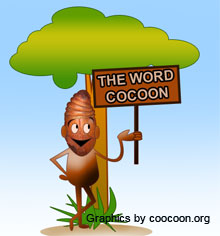The Origin Of The Word “Cocoon”
 The scientific word for “cocoon” is “chrysalis.” This is the pupal form that insects enter into after they have been born. It occurs as silk is secreted from 2 glands while the insect works in a figure 8 to wrap it around itself. This silk will then harden whenever it touches the air.
The scientific word for “cocoon” is “chrysalis.” This is the pupal form that insects enter into after they have been born. It occurs as silk is secreted from 2 glands while the insect works in a figure 8 to wrap it around itself. This silk will then harden whenever it touches the air.
The word “chrysalis” actually comes from the Greek word “crusoz,” which means gold. This is in reference to the color of the Nymphalid pupae, which is composed of 5,000 different butterflies that are located throughout the world. On the other hand, the term pupa is the scientific word that is used to describe this stage of a butterflies life.
When an insect enters into the pupa stage, most of its adult body parts can be seen. It is in this pupa stage that a remarkable process starts to take place. This is when the contents that are inside of the cocoon actually turns into an adult butterfly. The process can take as little as two weeks with monarch butterflies, to an entire wintertime as some insects use their cocoon to hibernate. These insects will then hatch when the springtime brings about warmer weather.
Since the insect is in hibernation, it cannot avoid any potential predators. For this reason, it needs to be camouflaged really well. Most of these cocoons are also located in cool, dark, damp places where other insects would not want to go. One such place would be underground. However, there are some cocoons that use their cremaster to help them hang by their silken pad onto such things as the underside of a roof.
Right before the adult butterfly actually hatches, its pupal skin will become transparent. Its wing pattern will also become visible inside of the cocoon. This is because this cocoon time is when these insects actually grow their wings and reproductive system in order that they can now emerge as an adult insect.
Bee Cocoons
What is a Cocoon
Cocoons in the winter time
How long Cocoon Last?
Silk Made From Cocoon
Silkworm Cocoon
Orgin of word Cocoon
The Surprises in Cocoons
Types of Insects in Cocoon
Butterfly or Moth Cocoon
Making of Cocoons
Ant – Cocoon Connection
From Cocoon to Adult: Role of Hormones
Cocoon that resembles a Bag
Cocoon Architecture
Mud Cocoons
Interesting Cocoons
Cocoon Food
Glochidium Cocoon
Sleeping Bag Cocoon
Cremaster, Nature’s Velcro
Frog Cocoon
Earthworm Cocoonv
Cocoon Rattles
Mites And Bee cocoon
Say No to Silk
Cocoon Inside Cocoon
Sensing From Inside Cocoon
Cocoon That Resembles Rabbit droppings
Hammock Shaped Cocoon
Chipwood Cocoon
Slime Cocoon
Cocoon For Eggs
